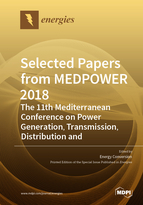Selected Papers from MEDPOWER 2018—the 11th Mediterranean Conference on Power Generation, Transmission, Distribution and Energy Conversion
A special issue of Energies (ISSN 1996-1073).
Deadline for manuscript submissions: closed (10 May 2019) | Viewed by 33755
Special Issue Editors
Interests: power system dynamics and control; smart grids; renewable energy systems; WAMS; maintenance of power system elements
Special Issues, Collections and Topics in MDPI journals
Interests: electrical engineering; research and development; geographic information systems; power system analysis; project management; risk analysis
Special Issues, Collections and Topics in MDPI journals
Interests: power markets, smart grid, optimization and control
Special Issues, Collections and Topics in MDPI journals
Special Issue Information
Dear Colleagues,
The 11th Mediterranean Conference on Power Generation, Transmission, Distribution and Energy Conversion, held in Dubrovnik, in 2018, provided a platform for professional power engineers, technicians, researchers, scholars, computer scientists, and other industry specialists, where state-of-the-art developments in academia and industry were discussed, creating opportunities for networking and collaboration through a series of presentations, talks, discussions, and special sessions.
MEDPOWER 2018 focused on all aspects of power system operation, integration of ICT and energy systems, as well as addressed challenges in energy markets, regulation, and power system management.
Prof. Dr. Igor Kuzle
Prof. Dr. Tomislav Capuder
Prof. Dr. Hrvoje Pandžić
Guest Editors
Manuscript Submission Information
Manuscripts should be submitted online at www.mdpi.com by registering and logging in to this website. Once you are registered, click here to go to the submission form. Manuscripts can be submitted until the deadline. All submissions that pass pre-check are peer-reviewed. Accepted papers will be published continuously in the journal (as soon as accepted) and will be listed together on the special issue website. Research articles, review articles as well as short communications are invited. For planned papers, a title and short abstract (about 100 words) can be sent to the Editorial Office for announcement on this website.
Submitted manuscripts should not have been published previously, nor be under consideration for publication elsewhere (except conference proceedings papers). All manuscripts are thoroughly refereed through a single-blind peer-review process. A guide for authors and other relevant information for submission of manuscripts is available on the Instructions for Authors page. Energies is an international peer-reviewed open access semimonthly journal published by MDPI.
Please visit the Instructions for Authors page before submitting a manuscript. The Article Processing Charge (APC) for publication in this open access journal is 2600 CHF (Swiss Francs). Submitted papers should be well formatted and use good English. Authors may use MDPI's English editing service prior to publication or during author revisions.
Keywords
- Power system reliability and security
- Blackout prevention, system resilience and restoration
- Wide-area monitoring and control
- Power system dynamics
- Power system protection
- Multi-energy systems
- Electro-mobility
- Distribution system monitoring, operation and control
- Aggregation of distributed energy resources
- Flexible sources at the distribution level
- Power electronics and HVDC
- Mathematical and computational issues in modelling and simulation
- Forecasting methods
- Power system planning and operation
- Asset management
- Very high integration of renewable energy resources
- Distributed storage systems
- Power system economics, energy markets and regulation
- Uber like models, energy communities, microgrids
- Uncertainty and risk management methods
- Energy efficiency
- Distribution level market
- Peer to peer trading
- Cyber security in power systems operation and control
- ICT-driven intelligent and autonomous controls
- Modelling of cyber-physical energy and communication systems
- Concepts and ICT solutions for flexible prosumers
- Data-driven modelling and big data management
- Machine learning, statistics and computational intelligence
- Geographic information systems energy system applications








